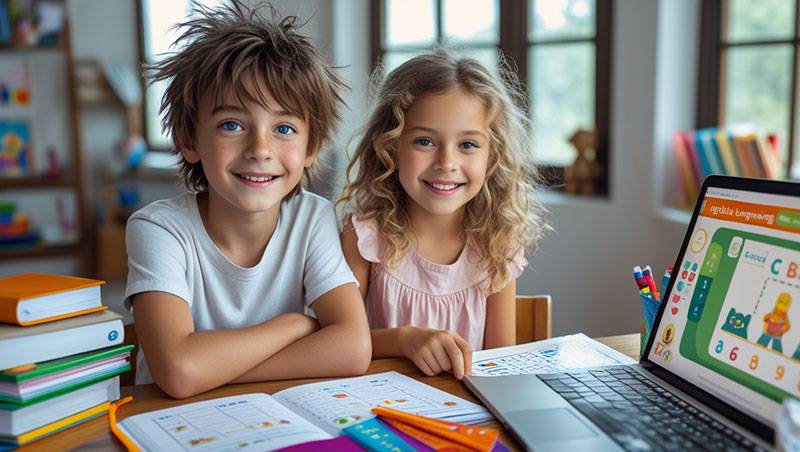How Can Kids Learn English Easily?
1. Introduction – Why Kids Have an Advantage
Regarding language acquisition, children approach their education like sponges. Their brains are set to pick up fresh languages more quickly than those of adults. This helps them to pick up English, one of the most often used languages worldwide, with a special edge. Understanding how kids can learn English more easily involves recognizing this natural ability and combining it with engaging, age-appropriate strategies.
Children pick up language skills rapidly in the correct surroundings, whether they be at home, in a classroom, or via digital media. This article offers useful English learning tips for kids and shows how different approaches might make the road to fluency enjoyable and successful.
2. Interactive and Fun Approaches
Children flourish in fun, thus early on learning should never be a chore for them. Including play into the process helps them to remain interested and absorb fresh vocabulary far more easily. These lighthearted approaches could help children pick up English:
Songs and Rhymes: Catchy songs and rhymes aid in children’s memory of phrases and vocabulary. Particularly successful are classic nursery rhymes or contemporary teaching songs with repeated structures.
Flashcards: These are effective but basic tools. To strengthen memory and increase vocabulary, use vibrant flashcards including pictures and words.
Games: Word puzzles, matching games, memory games, and board games with English directions help children learn while also providing entertainment value.
Apps: There are numerous apps designed to teach English for beginners kids. These usually feature interactive lessons, progress tracking, and fun quizzes that adapt to a child’s level.
Interactive tools help youngsters develop confidence and a sense of accomplishment in addition to knowledge.
3. Daily English at Home
First classroom is home; parents are the first teachers. Including English into regular activities is one of the easiest approaches to teach beginners’ children the language. Here’s the approach:
Name household objects (such as a door, table, spoon) using English names. This passive exposure naturally increases vocabulary.
Daily Conversations: In daily contacts, speak in basic English. Words like “Good morning,” “Wash your hands,” or “Let’s eat” start to become second nature.
Story Time: Read aloud English stories. Select books with straightforward language and images. Children begin to listen and observe begin to link words with meanings.
Ask children to name English versions of colors, shapes, or objects. Let them share what they observe or experience, so motivating them to actively apply new words.
Learning flows easily and stress-free thanks to English’s natural and informal use.
4. Using Videos and Cartoons for Learning
There are countless chances for English education presented by modern technologies. For those who learn best visually and auditory, cartoons and videos are quite useful. These are a few ways they help:
Shows and cartoons expose children to native accents and proper pronunciation—a crucial component of language acquisition.
Many cartoons employ repeated phrases to help young viewers memorize common words.
Even if they don’t know every word, visual storytelling helps children grasp meaning through context.
Platforms like YouTube Kids provide instructional videos where characters ask questions and pause for answers, so promoting interaction.
Rich in vocabulary and geared for young readers, some advised shows include Peppa Pig, Dora the Explorer, and Sesame Street.
5. Structured Courses vs. Informal Learning
Many times, parents question whether to stick to unofficial approaches or sign their kids into official English courses. There are advantages in both methods.
Structured Classes
- Clearly state your curriculum and progression.
- Add regular evaluations.
- Provide directions from experienced educators.
- Apply tried-upon tools and instructional strategies.
Children needing consistent practice or those getting ready for tests will especially benefit from structured learning.
Unstructured Learning
- adaptable and catered to a child’s hobbies.
- more at ease and pressure-free.
- inspires inquiry and originality.
Often the best outcomes result from combining both approaches. While you continue informal exposure through books, games, and conversation, enroll children in organized programs.
6. Best Practices for Parents and Teachers
Parents and teachers alike must use approaches that appeal to younger students if they are to guarantee success. Here are some ideal practices:
- Be patient and positive: Learning a language is a journey. Celebrate little successes and steer clear of fault-oriented criticism.
- Establish a Routine: One must be regularly exposed. Plan daily time for songs, reading, or interactive lessons.
- Use Praise and Rewards: Praise and rewards help one to develop confidence. Reward right use and give little prizes for advancement.
- Set Realistic Goals: Create reasonable expectations for fluency overnight. One skill at a time—such as learning colors this week—then animals the following.
- Promote group learning since many children learn English best among friends. Language clubs or group projects can inspire them to speak more naturally.
- Track screen time: Even if videos and apps have value, balance is absolutely vital. Combine actual interactions with screen-based learning.
To creatively reinforce vocabulary, teachers should also include role-play, narrative, and drawing exercises.
7. Conclusion – Encourage, Don’t Pressure
Making the experience fun and stress-free is the secret to enable children pick English. Children learn best when they are confident and motivated; they do not learn best under pressure or when they are compared with other children.
Teachers and parents should concentrate on helping their children to develop a love of language. Let children investigate English via stories, songs, and theater instead of drilling grammar rules. Establish language-rich surroundings where English organically permeates every day living.
Remember; every child picks things at their own speed. English for beginners kids can be both enjoyable and quite successful with the correct tools, approaches, and help. Start small, keep consistent, and acknowledge every advance on the road of learning English.



